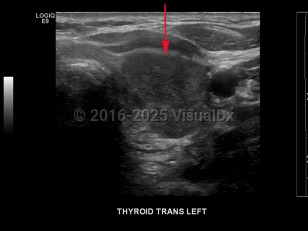Signs and symptoms include a neck lump or swelling, neck pain, hoarseness, dysphagia, dyspnea, and/or persistent cough. Erythroderma may rarely be a cutaneous manifestation of malignancy.
Thyroid cancer is classified based on histologic features:
- Papillary thyroid cancer – The most common type of thyroid cancer (approximately 85% of cases), often with diagnosis at an early stage with good overall prognosis. Characteristic histologic findings include psammoma bodies, cleaved nuclei with an "Orphan Annie" appearance, and the formation of papillary structures. Of note, it is now suggested that the encapsulated follicular variant of papillary thyroid carcinoma, which has a very low risk of adverse outcome, be reclassified as noninvasive follicular thyroid neoplasm with papillary-like nuclear features.
- Follicular thyroid cancer – The most common type of thyroid cancer in iodine-deficient regions of the world. It is often difficult to diagnose with fine-needle aspiration due to a lack of distinguishing features. Prognosis is poor if diagnosis is made at an advanced stage of disease.
- Anaplastic thyroid cancer – A poorly differentiated and aggressive form of thyroid cancer. Most patients die within 6 months of diagnosis.
- Medullary thyroid cancer – This can either be sporadic or familial as part of multiple endocrine neoplasia type 2A (MEN2A), type 2B (MEN2B), or medullary thyroid cancer without other features of MEN. Surgical resection is the preferred method of treatment, with elevated calcitonin levels post-surgery indicating residual disease.



